An Tir Internal Letter for January, AS XXXIX / 2005 CE
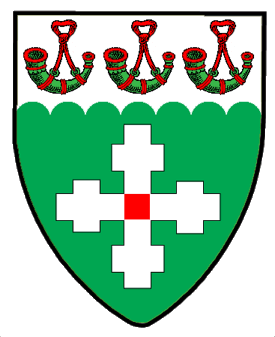
Baron David of Moffat, Lions Blood Herald
David Hunter of Montlaw
1703 Crosby Ct SW *
Tumwater, Washington 98512
360-705-0550 or amoffatamoffat@juno.com
3 January 2005
Unto the Commenting members of the An Tir College of Heralds does David of Moffat, Lions Blood Herald, send these greetings.
COMMENTARY ON THIS LETTER IS DUE 17 MARCH 2005
As promised last month, the January 2005 Internal Letter is hopefully coming out earlier than has been the practice for the last several years.
The February 2005 Lions Blood Meeting will occur on 20 February 2005 at my residence. Directions to my house are: Take your favor route to I-5. Travel I-5 to exit 104 (highway 101) in Olympia, Washington. Take exit 104, and get into the rightmost lane as quickly as possible. Take the first exit off of Highway 101, which is Cooper Point, Auto Mall, Evergreen Parkway, and Crosby Blvd. At the top of the exit ramp, get into the center lane turning left over the freeway. Turn left. Staying in this lane, go through three lights. You are now on Crosby Blvd. Stay on this road until you reach Crosby Court, past the dead end sign. Turn right into Crosby Ct, and turn left into the first driveway.
Letter of Acceptance and Returns
The following actions were taken by Laurel Sovereign of Arms in the July 2004 LoAR, published 23 December 2004:
Acceptances:
- Daria Baird de Navarre. Badge. (Fieldless) a frog sejant vert.
- Gwenlian Catharne. Device change.Per saltire sable and azure
This is clear of Albrechtus Vagus: Per pall arrondi sable, azure and argent. RfS X.4.a.ii.c regarding Field-Primary Armory says “independent changes to the tincture, direction of partition lines, style of partition lines, or number of pieces in the partition may be counted separately when comparing two pieces of field-primary armory.” (emphasis added) There are separate CDs for the number of pieces, and for changing the style of the line from straight to arrondy. The latter was established by the following precedent:[Quarterly Or and vert] This device does not conflict with Sven Förlorad, Quarterly arrondi sable and Or. There is one CD for changing the tincture of the field. Recent precedent has been mixed about whether there is a CD for making a field division arrondy. The weight of the recent precedent and the commentary is in favor of giving a CD between these two lines. This is an SCA choice (rather than one which can be based on period evidence). The weight of precedent, and the fact that there is a visual distinction between a straight and an arrondy line, indicates that we should give a CD for this change. [Br{o,}ndólfr the Stout, o3/03, A-Middle]
Her previously registered device, Sable, on a bend sinister azure fimbriated three dogwood blossoms palewise argent seeded Or, is retained as a badge. - Gwenlian Catharne. Badge.(Fieldless) A lozenge azure.
- John Catharne. Badge. (Fieldless) A lozenge flory at the points Or
This is clear of Solveig Throndardottir: (Fieldless) A lozenge Or, with one CD for fieldlessness and one for adding the highly prominent fleurs-de-lys at the points. - Katin inghean Neachtain. Name and device. Per chevron vert and sable, two cats sejant contourny and an open scroll argent.
This name combines English and Gaelic in the same name; this is one step from period practice. - Katin inghean Neachtan. Badge. (Fieldless) On an open scroll fesswise argent a cat couchant contourny sable
- Kieran Moncrieff of Dundee. Device. Azure, on a chevron fracted argent five triquetras azure and on a chief embattled argent three crosses clechy azure.
The question was raised at the [Wreath/Laurel] meeting whether the crosses were clechy or patonce. As there is not a CD between these two types of cross, it is safe to go with clechy as submitted, though the submitter might be advised to draw the crosses more clearly. - Máel Dúin mac Cormaicc. Name and device. Or, on a pile throughout vert between two grenades sable enflamed gules a rabbit rampant argent.
Submitted as Máel-dúin MacCormaicc, the submitter requested authenticity for 8th -10th C Manx language/culture and accepted minor changes. Unfortunately, no information is available for Manx names at that time.
With a few tweaks, this becomes a very reasonable 8th-10th C Irish name. In the 8th-10th C, patronymics, such as mac Cormaicc were literal not inherited. However, the form, MacCormaicc is typically used to show an inherited surname; literal patronymics typically separate the [particle] and the patronymic with a space and show the particle in lowercase. In addition, the documented forms of the given name appear without the [hyphen]. We have therefore changed the name to Máel Dúin mac Cormaicc to make this name fully consistent with 8th-10th C Irish Gaelic practice. - Martha at Gore. Device. Per pall argent, counter-ermine, and vert, in chief a spinning wheel gules.
While the position of the spinning wheel in this case is forced to chief by the tinctures of the field, we have specifically blazoned the wheel's position at the request of several scribes at the meeting. - Patrekr Kórason. Name.
- Patrekr Kórason. Badge. (Fieldless) A snake glissant palewise argent
- Svana in litla. Name and device. Gules, an oak tree eradicated between two goats statant respectant Or.
Submitted as Svava in litla, this name is presumptuous according to the Rules for Submission VI.2. which says “[names] containing elements that allude to powers that the submitter does not possess are considered presumptuous… Such claims include… given names that were never used by humans, like the names of some Giants or Dwarves in Norse mythology.” According to the submitted documentation, Svava is a Valkyrie; no documentation was submitted or any found that this name was ever used by humans. We have changed the given name to Svana, a name with a similar look and feel found in the Landnámabók. - Tamlin Mac Gryhme of Westray. Badge. (Fieldless) a mullet of six points voided and interlaced within and conjoined to a serpent involved sable.
Returns
- Patrekr Kórason. Device. Per pale sable and gules, two snakes erect glissant argent.
This conflicts with the Shire of Eikdal, whose device was originally blazoned as Gules, two serpents erect glissant respectant argent supporting in chief a laurel wreath Or. However, a visual check of Eikdal's device makes it obvious that the laurel wreath is a maintained charge. So while there is one CD for changing the field, that is the only countable difference, as the maintained laurel wreath cannot count for difference. (Eikdal's device is reblazoned elsewhere in this letter.) - Tamlin Mac Gryhme of Westray. Device. Argent, a mullet of six points voided and interlaced within and conjoined to a serpent involved head to sinisterd, sable, on a chief rayonny of alternating straight and wavy rays sable two roundels argent.
The occurrence of rayonny lines of division is an uncommon late-period phenomenon, which occurs far more frequently in SCA armory than it does in late-period armory. This particular depiction is apparently found only in a post-period tract (albeit one from our “gray area”). It also blurs the distinction between rayonny and indented, between which there is a CD as lines of division.
al-Jamal notes:…even Guilllim notes it as a “rare” charge, stating that “had not the shining raies of this glistering Pale extraordinarily invited me to gaze upon the rarity of this bearing I should… omitted to have here demonstrated this Coat-armour”, and as has been noted before, “we must draw our general rules from the common usage, not the anomaly .” (LoAR August 1987, p. 16). Given that the near-period usage is so “rare”, and that the emblazon here does not match the near period emblazon, and that the emblazon here confuses the eye with its half-rayonny/half indented line, I think this should be returned.
There was some confusion as to whether the all-wavy and alternating lines were both gray-area-only. The all-wavy does appear to occur in later period while the for alternating we have only the grey area example. We therefore concur with al-Jamal that the alternating depiction is too far from period practice and therefore not registerable.
NEW SUBMISSIONS:
| 1. Alexandros Khristodoulopoulos | River’s Bend | Name - New |
|
The submitter will not accept major changes to his name, and wants a male name. If his name must be changed, he cares most about the meaning, which his documentation suggests means “Alexander son of Christodoulos.” He is interested in a name authentic for “10th to 13th Century Greek.” His documentation consists of a St. Gabriel report no. 2887. This indicates that Aléxandros is found twice between 1025 and 1261, and once in 1322. In addition, the submitter provides a extract from a website with Byzantine seals found at http://www.kcl.ac.uk/humanities/cch/PBE/seals/S2/167.htm which is the seal for Alexandros Kabasilas, dated to c. 1080-1100. Khristodoulopoulos is documented from the same St. Gabriel report. This indicates that Khristódoulos is Greek given name found twice between 1025 and 1261. The report indicates the patronymic form is created by adding –opoulos to the name, resulting in a patronymic of Khristodoulópoulos. The submitter also provides a Byzantine seal from http://www.kcl.ac.uk/humanities/cch/PBE/seals/Se12/1159/htm showing a seal containing the name Christodoulos dated to the early 10th century to 1204. |
||
| 2. Ambraisia O’Meghera | Myrgan Wood | Name & Device – New |
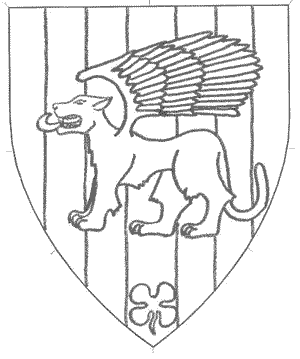 |
Paly of seven sable and azure, a winged domestic cat statant argent in base a four leaved clover Or. The submitter will accept any changes to her name and wants a female name. If changes are required, she cares most about the sound. She is interested in a name authentic for the Irish language or culture. A holding name is allowed. Ambraisia is asserted to be “variant of Ambrosia – female equivalent of Ambrose – greek meaning ‘immortal.’” Meghera is asserted to be “gaelic meaning ‘of the plains.’” |
|
| 3. Argyle MacMillan | Cold Keep | Name & Device – New |
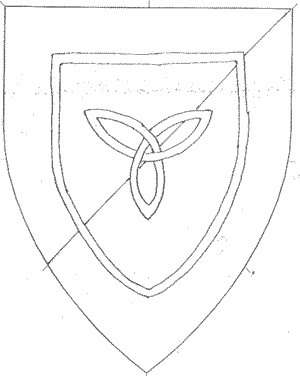 |
Per bend sinister sable and gules, a triquetra inverted argent within an orle argent The submitter will accept any changes to his name, and wants a male name. He cares most about the sound if changes are required. He is interested in a name authentic for the language and culture of an unspecified area and time. He will accept a holding name. He notes his primary preference is the given name Argyle. He asserts that this is derived form a place name and “it should be acceptable as the first duke of Argyll (who at said point could be referred to as Argyll) was created in the 15th C. Therefore, it should be reasonable to assume that Argyle could be an acceptable first name for personas from a period earlier than 15th C. It could also be argued that Argyle is a combination of Archilbald and Gylles, two accepted scottish names.” However, if neither Argyle or Argile are acceptable, he would prefer “to have the first name Argill, derived from Arcill.” For this name he cites http://www.medievalscotland.org/scotnames/ simplescotgaelicnames12.shtml. Finally he gives a list of preferences for a given name: 1)Argyle 2)Argile 3)Argyll 4) Arg 5) Argill He provides no documentation for MacMillan, but does not that if it is necessary to use an earlier form of the surname to get the given name he wants, he will use the Gaelic form of MacMillan, which he asserts is MacMhaolain. |
|
| 4. Argyle MacMillan | Cold Keep | Badge – New |
 |
(Fieldless) a triquetra inverted argent His name is submitted above. |
|
| 5. Catrina Makcrie of Berwick | Wyewood | Badge - New |
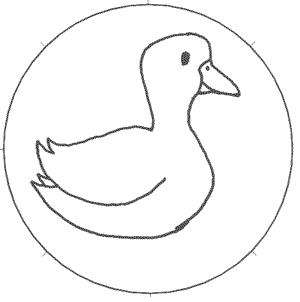 |
(Fieldless) a duck naiant contourney Or The submitter’s name was registered in the January 2002 LoAR |
|
| 6. Chikakukawa No Shunzei | Myrgan Wood | Name & Device – New |
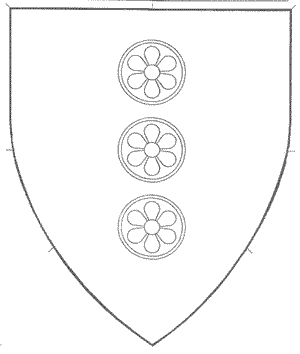 |
Or, in pale three sex foils Purpure seeded Or each within an annulet Purpure The submitter will accept any changes to her name and does not care about the gender of the name. If changes must be made, she cares most about the meaning which she gives as “Chikakukawa – by the river”. She is interested in a name authentic for language and/or culture, but does not specify. She will allow a holding name. She provides photocopies from P.G. O’Neill, Japanese Names, where p. 7 has Chika; p. 47 has Kanakubo marked with the –ku- highlighted, and p. 46 has Kamikawa marked with the –kawa highlighted. She also provides an excerpt from the Random House Japanese Dictionary, p. 21 where chikaku is shown to mean “nearby” and p. 84, where kawa is shown to mean “stream, river.” Shunzei is found in O’Neill, p. 205(?). No documentation is provided for the No. |
|
| 7. Citvogel von der Ödland | Myrgan Wood | Name & Device - New |
 |
Or, a “Wolf” rampant Sable charged on the should with an “Edelweiss” proper and holding in the sinister forepaw a “stag’s antler” gules, a “chief“ bendy sinister of six argent and sable. The submitter will accept any changes to his name and wants a male name. He expresses no preferences as to how the name may be changed if necessary. He does not care for an authentic name. He allows a holding name. Citvogel is taken from the submitter’s family ancestry, but no evidence of this is provided. He asserts it means “hooded or cowled bird”, and that it comes from the Schwaben region. He also relies on Bahlow, Deutsches Namenlexikon, (s.n. Morhard(t)), where a Morhart Citvogel is dated to 1286. Von der Odland is asserted to be a descriptive meaning “’from’ or ‘of’ the wastelands.” |
|
| 8. Derian le Breton | St. Bunstable | Name & Device – New |
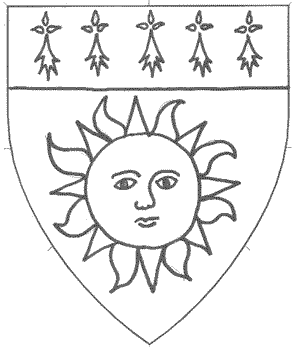 |
Vert, a sun in its glory and on a chief argent five ermine spots in fess sable The submitter will not accept major changes to his name and wants a male name. If changes are required, he cares most about language and culture, and he wants a name authentic for “13th c. Brittany” language or culture. He will allow a holding name. Derian is dated to 834 to 1101AD in de Courson, Cartulaire de lAbbaye de Redon en Bretagne, pp. 2, 226,304, 322. It is also found in a website for “Universitaires bretons au Moyen Age”, however, while copies are provided, no address is legible. le Breton is found as the byname on more than 30 persons in the Universitaires bretons au Moyen Age website. In addition, Colm Dubh, “An Index to the Given Names in the 1292 Census of Paris” (http://www.sca.org/laurel/names/paris.html) has several men of this name, including Alain le Breton and Anfroy le Breton. |
|
| 9. Evrard de Valogue | Wyewood | Name & Device – New |
 |
Argent, on a pale between two pheons azure an arrow inverted headed of a fleur-de-lis Or. The submitter will accept any changes, and wants a male name. If changes are required, he cares most about the language and culture, and is interested in a name authentic for the 14th Century French language and culture. He will accept a holding name. Evrard is found as a male given name in ‘tude dAuthroponymic Picard’ by Marie-Therese Morlet on page 88, where a single entry is found in 14 th Cent. at Eu. De Valogue is asserted to be a locative surname meaning “from Valogue.” The submitter asserts that this town is in Normandy, and was mentioned in the 14 th Century Froissarts Chronicles, Book II, chapter 161. |
|
| 10. Gareth Bydaweyr | Myrgan Wood | Name & Device – New |
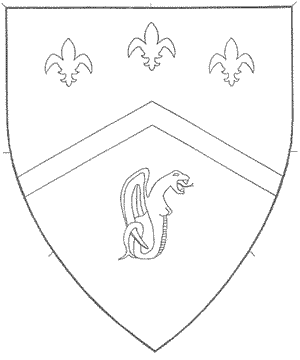 |
Sable, a sea python erect, breasted of a woman, winged, sinister Or, a chevron Or between three fleur-de-leis Or The submitter will accept any changes to his name, and wants a male name. If changes are required, he cares most about the meaning, which he gives as “composed to mean by the weir”. He is interested in a name authentic for “13 th c. Welsh” He will allow a holding name. Gareth comes from Withycombe, Oxford Dictionary of English Christian Names, 3rd, (s.n. Gareth), where the author indicates a child of this name was baptised in 1593 in Wigan. He cites Reaney, Dictionary of British Surnames, 2nd, (sub Wear), where the author lists Peter de la Were in 1242, and John atte Wer in 1332, where weir is a dam or fish trap. He asserts the surname is constructed in the style of an English locative name “by the weir” following the pattern of Bitheway, Bethewy, Bithewuther, and Bithe welle, and that “bydaweyr – welsh deviation.” |
|
| 11. Giuliana Maria di Grazia | Wyewood | Name & Device – New |
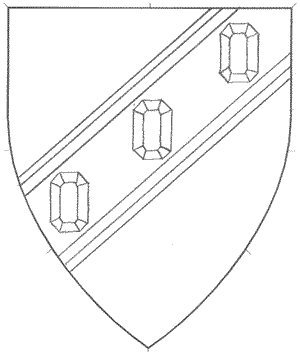 |
Per bend sinister sable and azure, on a bend sinister cotised argent 3 step-cut gems palewise azure. The submitter will not accept major changes to her name, and wants a female name. If changes are required she cares most about the language and culture, and is interested in a name authentic for the “Italian (Florentine)” language or culture. She will accept a holding name. Giuliana and Maria are both found as womens given names on Rhian Lyth of Blackmoor Vale, “Italian Renaissance Womens Names” (http://www.sca.org/heraldry/laurel/names/italian.html). Grazia is found as a surname in Herlihy et al, “Florentine Renaissance Resources: Online Tratte of Office Holders 1282-1532” ( http://www.stg.brown.edu/projects/tratte/doc/ SURNAM1.html) where 54 persons of this name are indicated. In addition, de Felice, Cognomi (sub Grazia) shows an alternative form for this name as di Grazia. |
|
| 12. Giuliana Maria di Grazia | Wyewood | Badge – New |
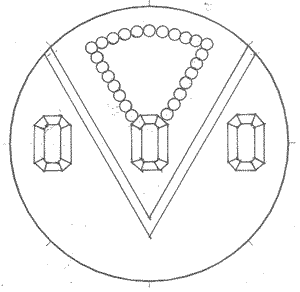 |
Sable, on a pile azure fimbriated between two step-cut gems palewise argent a step-cut gem palewise pendent from a necklace of beads argent Her name is submitted above. |
|
| 13. Giuliana Maria di Grazia | Wyewood | Badge – New |
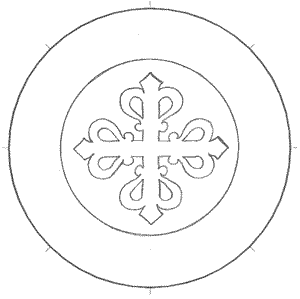 |
Sable, on a roundel argent a cross of calatrava azure. Her name is submitted above. |
|
| 14. Guy the velvet hammer | Grimwith | Name & Device – New |
 |
Vert Latin Cross on Field of Argent Reblazon: Argent a Latin cross formy vert The submitter will accept any changes to his name, and wants a male name. If changes are required, he cares most about the meaning (unspecified). He is interested in a name authentic for “9th-10th cent French Norman born and raised in Norway.” He will accept a holding name. No other documentation is provided. |
|
| 15. Illyanth Farraday | Myrgan Wood | Name & Device – New |
 |
Argent, in saltire a sword sable and a rose gules, slipped and leaved vert, on a chief azure an open book Or. The submitter will not accept major changes to his name, and wants a male name. If changes are required, he cares most about sound, and is interested in a name authentic for the “Celtic/Gaelic” language/culture. He will accept a holding name. Illyanth is asserted to be “Celtic variant of Latin Illian (meaning ‘youth) (unique)” Farraday is asserted to be “Celtic/Gaelic from Farraideach (meaning ‘inquisitive’ or ‘curious’).” |
|
| 16. Judith Greanwod | St. Bunstable | Name & Device – New |
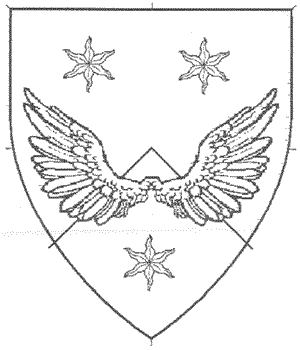 |
Per chevron azure and vert, a vol between three estoiles argent The submitter will accept any changes to her name and wants a female name. If changes are required, she expresses no preferences to the manner, but wants a name authentic for the 16th century English time period. She will accept a holding name. She provides blanket permission to conflict with this name. Judith is documented from the following web sites:
Greanwod is found in Julie Stampnitzky, “Surnames in Durham and Northumberland, 1521-1615” www.yucs.org/~jules/names/parish/surnames.html where this spelling is dated to 1570. Copies of the websites of Mari, Aryanhwy, Forcester, and Julie are provided, but Aryanhwy 16 is missing the critical page. |
|
| 17. Kolbjörn Gylðir | Silverhart | Name & Device – New |
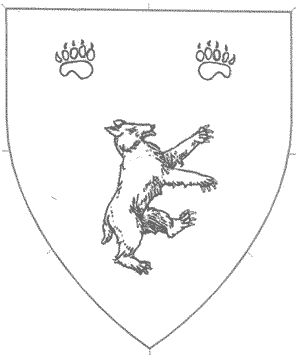 |
Or, a bear rampant to sinister and in chief two bear paw prints sable The submitter will not accept major changes to his name, and wants a male name. He does not express a preference if changes are required, but wants a name authentic for the “Norse” language and culture. He will accept a holding name. Kolbjörn is found in www.ellipsis.cx/~liana/names/ landnamambok.html as a name found twice in the source. Gylðir is found in www.ellipsis.cx/~liana/names/ vikbynames.html as a byname meaning howler or wolf. |
|
| 18. Kvigr Ivarsson | Myrgan Wood | Name & Device – New |
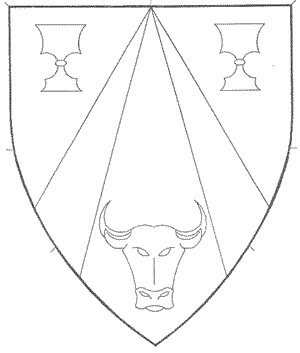 |
Gules, two piles inverted in point throughout Or between two chalices argent, on point a bulls head caboshed Argent. The piles are Or, the field is Gules, the other three charges are all argent. The submitter will accept any change to his name, and wants a male name. If changes are required he cares about the meaning (Young bull son of Ivar) and the language and culture (unspecified). He wants a name authentic for an unspecified language or culture. He will accept a holding name. Kvigr is documented from Geirr Bassi, The Old Norse Name, p25, where the word kvgr is listed as a byname meaning “young bull”, and from p. 13, where a given name Kvgr is listed. Ivarsson is asserted to mean son of Ivar. Geirr Bassi, p. 12 shows Ívarr as a given name, which under the rules on p. 17, becomes Ivarsson in the patronymic form. |
|
| 19. Linet Grimolfrsdottir | Myrgan Wood | Name & Device – New |
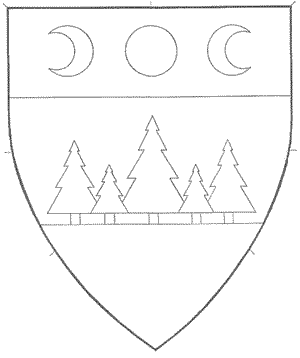 |
Argent, on a mount in base Vert, a hurst of pine-trees, in chief Sable three in-phase moons Argent The top 1/3 of the field is black. The in-phase moons are white. The center 1/3 of the field is white, with the tree tops green and the trunks yellow. The bottom 1/3 of the field is green. The submitter will accept any changes to her name, and wants a female name. If changes are required, she is most interested in an unspecified language or culture, and wants a name authentic for an unspecified language or culture. She will accept a holding name. Linet is asserted to be “daughter of Sir Persaunt and sister to Liones, of Castle Perilous (ch.131) Sir. T. Malory, “History of Prince Arthur, i. 120-153 (1470).” Grimolfrsdottir is asserted to mean “daughter of Grimolfr”. |
|
| 20. Malachi of Lloegyr | Silverhart | Name & Device – Resubmission – Kingdom |
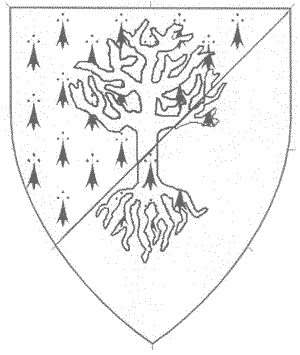 |
Per bend sinister ermine and sable, a tree blasted and eradicated counterchanged The prior submissions were returned in January 2003. The name was returned because no documentation could be found that Lloegyr was a real place name, in period or otherwise, noting the only documentation that could be found was to a role playing game. The armorial submission was returned for violation of the color-on-color rule of contrast. This has been addressed here. The submitter will not accept major changes to his name, and wants a male name. If changes are required, he cares about the language or culture, and wants a name authentic for the Welsh language or culture. He will accept a holding name. Malachi is asserted to be a “biblical name.” Lloegyr “A welsh (possibly Gaelic/Welsh) place name.” A series of emails provided suggests that this term refers to border towns occupied by the English. |
|
| 21. Renata von Silverhart | Wealdsmere | Name & Device – New |
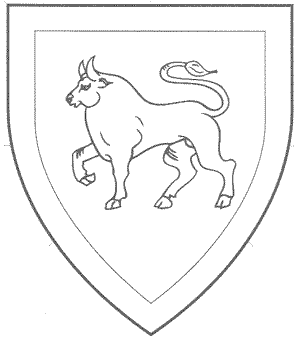 |
Argent, a blue blue statant within a bordure sable Reblazon: Argent a bull statant azure within a bordure sable The submitter will accept any changes to her name and wants a female name. If changes are required, she is most interested in language and culture, and wants a name authentic for language and culture, but does not specify what language or culture. She will accept a holding name. Renata is documented from Grunfeld, The Princes of Germany, p. [not specified]. The text discusses Albert V, Duke of Bavaria and a wedding in 1568 between his son William and Renata, oldest daughter of the Duke of Lorraine. No documentation is provided for von Silverhart, although Silverhart is a registered branch name in An Tir. |
|
I remain in Service to the Crown and Kingdom of An Tir,

David of Moffat
|
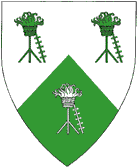
HTML (top half of page) by: 
HTML (bottom half of page) by: |